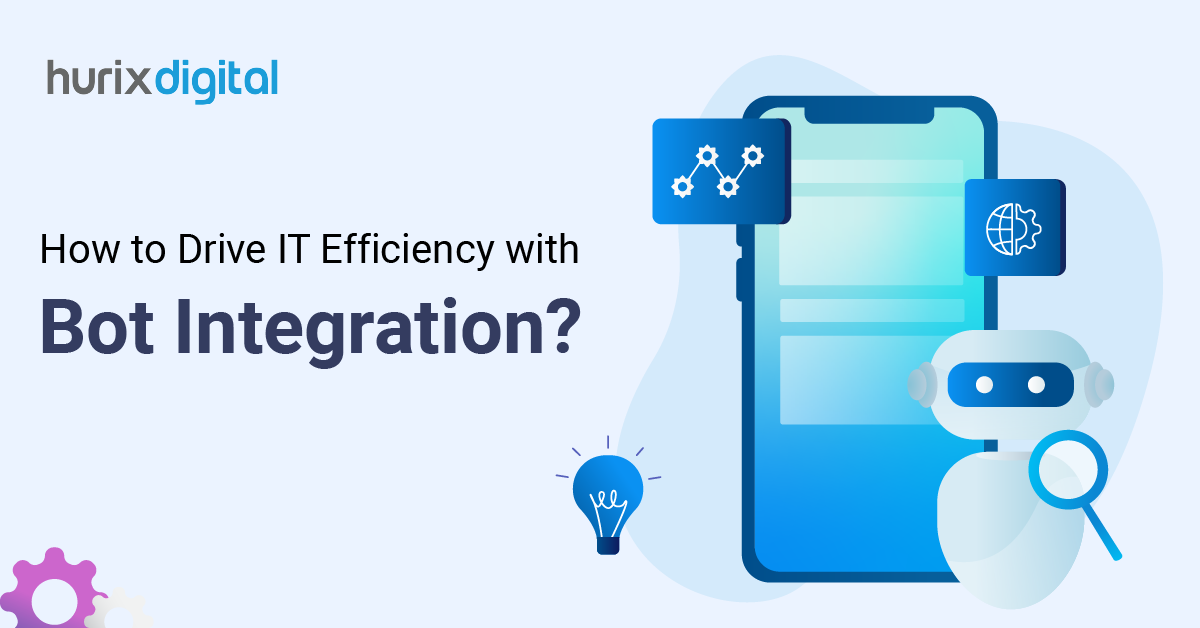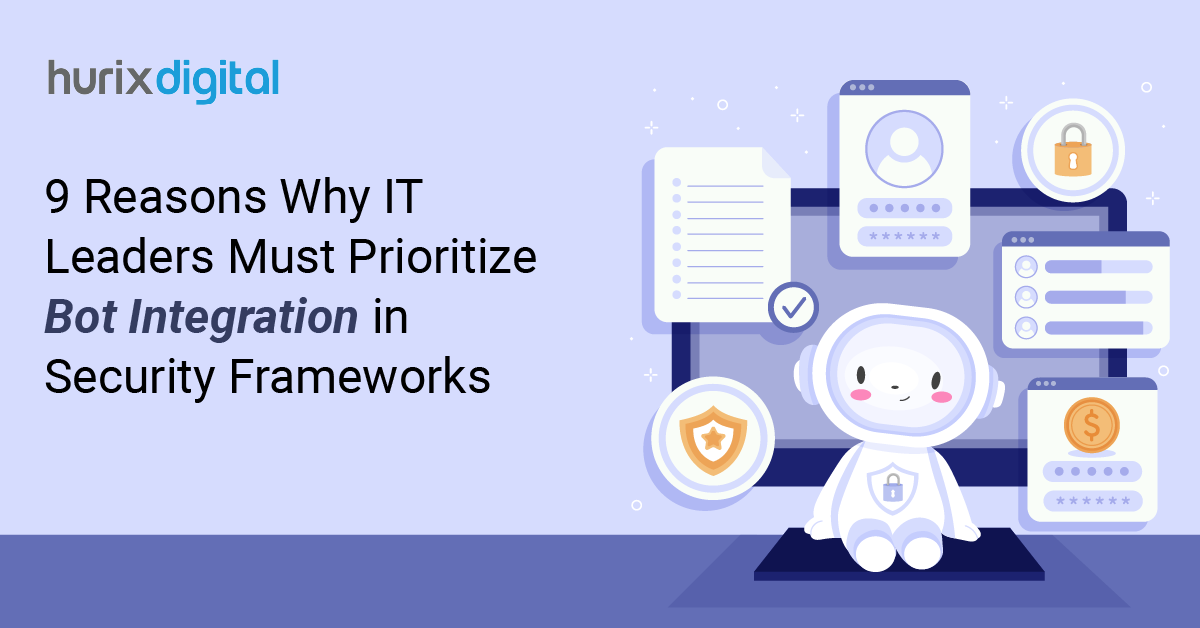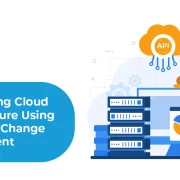
How to Drive IT Efficiency with Bot Integration?
Summary
This blog discusses how conversational AI bots streamline IT operations, addressing challenges and enhancing efficiency through the automation of repetitive tasks and self-service support.
The IT services industry has grown by almost 52% since 2020 and is currently valued at $1,420 billion as of 2024. While this signifies tremendous growth, it also indicates a rising pressure for IT departments to deliver more with less.
The roadmap to meeting expectations and supporting business growth comes with several hurdles. Manual tasks, repetitive processes, and numerous support tickets can greatly hinder productivity when managed inefficiently. Amidst this high-pressure environment, bot integration powered by conversational AI offers a revolutionary solution.
With the power to drive IT efficiency with intelligent support and RPA automation, businesses need to know how to make the most of bot integration to have a competitive edge. This guide explores its importance and key practices to incorporate for maximum efficiency and productivity.
Table of Contents:
- Understanding the Challenges of IT Efficiency
- What is Conversational AI and Bot Integration?
- How Bot Integration Streamlines IT Operations
- 5 Key Practices to Incorporate Bot Integration Effectively
- Building IT Excellence with Bot Integration
Understanding the Challenges of IT Efficiency
Before diving into improving IT efficiency with bot integration, let’s understand the challenges businesses face that make it so crucial.
As businesses grow more reliant on technology to field their growth and continuity, IT teams face numerous obstacles as they manage the increase in workload. To understand how AI plays a role, here are the challenges that CIOs and CTOs face:
1. Overwhelming Ticket Volume
IT support teams are challenged with a constant influx of support requests, ranging from simple password resets to complex technical issues. This overwhelming volume of tickets leads to inefficient use of valuable resources away from proactive initiatives and strategic planning.
2. Repetitive Tasks
Many IT tasks, such as software installations, user provisioning, and data entry, are repetitive and time-consuming. These activities are critical yet mundane, leading to burnout, reduced job satisfaction, and increased human error.
3. Database Management
Information about IT processes, procedures, and solutions is often scattered across various systems, documents, and team members. A haphazard knowledge base can hinder collaboration, slow problem-solving, and lead to inconsistencies in service delivery.
4. Unplanned Staff Shortages
IT departments frequently face challenges related to understaffing, skill gaps, and high turnover rates. In fact, these challenges snowball into the lack of personnel to address issues. Unplanned shortages will also strain resources, impact response times, and hinder the ability to deliver innovative IT solutions.
These key challenges are quite detrimental to how businesses flourish and the quality of the services they provide to their customers. With necessity driving innovation in this situation, conversational AI for IT efficiency enters as a game-changer.
Also Read: What is Business Simulation? Type & Benefits of Using Business Simulations
What is Conversational AI and Bot Integration?
Conversational AI is a branch of AI that empowers computers to understand, process, and generate human language.
This technology enables machines to engage in meaningful conversations through text or voice. Conversational AI effectively drives tools such as virtual assistants, allowing them to interpret user queries, provide relevant information, and complete tasks.
One application of conversational AI that has transformed every industry is bot integration. This futuristic application involves seamlessly incorporating conversational AI-powered bots into existing IT systems and processes. Bot integration focuses on handling routine tasks and providing support to enhance the overall efficiency of IT interactions between humans and machines.
With this quick overview, let’s dive into how bot integration enhances your business’s IT operations.
How Bot Integration Streamlines IT Operations
To effectively overcome the several challenges in the industry and efficiently achieve IT excellence, here’s how bot integration helps streamline IT workflows and operations:
1. Automates Routine Tasks
Bots can efficiently handle a wide range of repetitive tasks, from password resets and IT asset management to service desk ticket routing. This workflow automation frees IT staff to focus on higher-value activities requiring human expertise and creativity.
2. Provides Self-Service Support
Algorithms and machine languages drive conversational AI-powered bots. This allows businesses to offer 24/7 availability and immediate responses. Bots also empower end-users to resolve common issues independently, reducing the burden on IT support teams and improving overall user satisfaction.
3. Improves Data Management
AI can organize and manage essential knowledge bases. Bots with the right data sources efficiently provide access to relevant information, troubleshooting guidance, and even summarize critical issues. This promotes user self-sufficiency and streamlines knowledge sharing within the IT department.
When your bot integration delivers human-like services at higher efficiencies, your business can focus better on strategy, revenue, and bottleneck management instead of ground-level tasks.
Let’s move on to what practices will help you incorporate bot integration to maximum potential.
5 Key Practices to Incorporate Bot Integration Effectively
With advantages and concepts clear, here are five practices to maximize effective bot integration:
1. Identify High-Impact Areas
Pinpointing time-consuming or resource-intensive processes is the first step in efficiently integrating conversational AI into your IT operations. With a comprehensive report on what will yield the greatest impact, you can pursue automation more effectively.
This practice helps IT teams significantly improve efficiency, reduce errors, and free up valuable time for strategic initiatives. Here are vital tips to perform this analysis:
Tip 1: Conduct a thorough process mapping exercise to identify bottlenecks and repetitive tasks.
Tip 2: Prioritize tasks based on their frequency, complexity, and impact on overall IT efficiency.
Tip 3: Involve IT staff in the process identification to leverage their expertise.
Tip 4: Consider using process mining tools to visualize and analyze workflows.
2. Choose a Comprehensive Bot Tool
Selecting a bot integration tool whose solution aligns with your organization’s specific needs is another mandatory practice. A well-chosen platform provides the necessary tools and capabilities to build, deploy, and manage bots effectively.
Here are vital tips to consider while choosing your bot integration tool:
Tip 1: Evaluate platforms based on how you plan to scale AI in your business.
Tip 2: Prioritize its natural language processing (NLP) accuracy and integration capabilities.
Tip 3: Ensure the tool can handle and incorporate different types of bots (e.g., chatbots, virtual assistants, automation bots).
Tip 4: Your selection must come with the latest security features for maximum data privacy.
Tip 5: Experiment in test phases to evaluate their performance before going live.
3. Design User-Friendly Interactions
Ensuring user-friendly interfaces is an essential practice that you mustn’t overlook. The bot interface enhances user satisfaction and expedites adoption. Clear and intuitive interactions reduce frustration and increase the likelihood of users utilizing the top chatbot solutions for IT needs.
Here are three tips to keep in mind when implementing your bot:
Tip 1: Ensure your bot conversations are tuned to deliver simple and comprehendible language
Tip 2: Provide conversational AI algorithms with clear prompts and options to learn how to guide users effectively.
Tip 3: Consistently gather feedback from both users and reports from the bot to maintain usability.
4. Integrate with Existing Systems
Seamless integration of bots with existing IT systems ensures data consistency, reduces manual data entry, and improves overall efficiency. This practice also enables bots to access and leverage information from various sources to provide comprehensive and accurate responses.
Here are some tips to factor in for integrating your existing systems with your boot tool:
Tip 1: Develop a comprehensive integration plan outlining data flows and system interactions.
Tip 2: Utilize APIs to connect bots with different systems and applications.
Tip 3: Test integrations thoroughly to identify and resolve any issues.
Tip 4: Use integration platforms to simplify the process.
These practices, coupled with tracking bot utilization and regular knowledge base updation, will help you improve overall bot integration in your business.
5. Regularly Monitor and Refine
Regulatory guidelines constantly evolve to ensure AI tools do not create bias or security concerns. New algorithms and coding approaches are regularly introduced to improve conversational AI’s delivery of better chatbot integration for IT workflows.
Even the best conversational AI platforms must regularly review and adapt their processes to keep up with these changes and stay relevant. Here are three tips to strengthen your monitoring and improvement strategies:
Tip 1: Regularly audit your bot integrations by analyzing user interactions, response accuracy, and adherence to guidelines.
Tip 2: Implement surveys, questionnaires, or direct communication channels to gather user feedback and suggestions.
Tip 3: Develop KPIs and tracking solutions that monitor metrics such as response time, customer satisfaction ratings, and resolution rates in real-time.
Tip 4: Ensure all improvement steps are implemented in sprints and phases for clear and incremental results.
With these five practices in place, businesses can ensure their bot integrations stay robust and relevant.
Also Read: Improving Digital Accessibility with Assistive Technology-Friendly Content
Building IT Excellence with Bot Integration
IT is a demanding function that will continue to grow with the expanding digital space. Effectively using conversation AI and bot integrations will transform how businesses manage support requests, guide users, and maximize business productivity.
The concepts and tips we’ve elaborated on in this article will make the bot integration process nearly seamless. All that’s left is to select the right partner to devise workforce solutions that meet your business’s unique needs.
That’s where Hurix Digital is the perfect choice. With comprehensive business solutions, from training modules to implementation programs, we can achieve IT excellence through a clear journey.
So get started and schedule a quick discovery session with us today!

Currently serving as the Vice President of Technology Delivery Operations at HurixDigital, a prominent global provider of digital content and technology solutions for publishers, corporations, and educational institutions. With over 16 years of experience spanning EdTech and various domains, I hold certification as a SCRUM Product Owner (CSPO). My expertise includes operations, finance, and adept people management skills.





